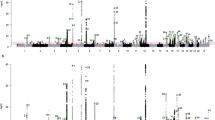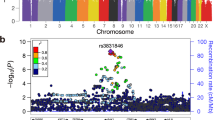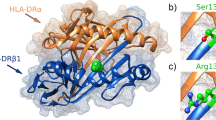Abstract
We conducted a meta-analysis to identify new susceptibility loci for testicular germ cell tumor (TGCT). In the discovery phase, we analyzed 931 affected individuals and 1,975 controls from 3 genome-wide association studies (GWAS). We conducted replication in 6 independent sample sets comprising 3,211 affected individuals and 7,591 controls. In the combined analysis, risk of TGCT was significantly associated with markers at four previously unreported loci: 4q22.2 in HPGDS (per-allele odds ratio (OR) = 1.19, 95% confidence interval (CI) = 1.12–1.26; P = 1.11 × 10−8), 7p22.3 in MAD1L1 (OR = 1.21, 95% CI = 1.14–1.29; P = 5.59 × 10−9), 16q22.3 in RFWD3 (OR = 1.26, 95% CI = 1.18–1.34; P = 5.15 × 10−12) and 17q22 (rs9905704: OR = 1.27, 95% CI = 1.18–1.33; P = 4.32 × 10−13 and rs7221274: OR = 1.20, 95% CI = 1.12–1.28; P = 4.04 × 10−9), a locus that includes TEX14, RAD51C and PPM1E. These new TGCT susceptibility loci contain biologically plausible genes encoding proteins important for male germ cell development, chromosomal segregation and the DNA damage response.
This is a preview of subscription content, access via your institution
Access options
Subscribe to this journal
Receive 12 print issues and online access
$209.00 per year
only $17.42 per issue
Buy this article
- Purchase on Springer Link
- Instant access to full article PDF
Prices may be subject to local taxes which are calculated during checkout

Similar content being viewed by others
References
Rosen, A., Jayram, G., Drazer, M. & Eggener, S.E. Global trends in testicular cancer incidence and mortality. Eur. Urol. 60, 374–379 (2011).
Howlader, N. et al. SEER Cancer Statistics Review, 1975–2009 (Vintage 2009 Populations) based on November 2011 SEER data submission, posted to the SEER web site, 2012 〈http://seer.cancer.gov/csr/1975_2009_pops09/〉 (2012).
Stang, A. et al. Gonadal and extragonadal germ cell tumours in the United States, 1973–2007. Int. J. Androl. 35, 616–625 (2012).
McGlynn, K.A. & Trabert, B. Adolescent and adult risk factors for testicular cancer. Nat. Rev. Urol. 9, 339–349 (2012).
Daling, J.R. et al. Association of marijuana use and the incidence of testicular germ cell tumors. Cancer 115, 1215–1223 (2009).
Trabert, B., Sigurdson, A.J., Sweeney, A.M., Strom, S.S. & McGlynn, K.A. Marijuana use and testicular germ cell tumors. Cancer 117, 848–853 (2011).
Lacson, J.C. et al. Population-based case-control study of recreational drug use and testis cancer risk confirms an association between marijuana use and nonseminoma risk. Cancer 118, 5374–5383 (2012).
Bromen, K. et al. Testicular, other genital, and breast cancers in first-degree relatives of testicular cancer patients and controls. Cancer Epidemiol. Biomarkers Prev. 13, 1316–1324 (2004).
Chia, V.M. et al. Risk of cancer in first- and second-degree relatives of testicular germ cell tumor cases and controls. Int. J. Cancer 124, 952–957 (2009).
Heimdal, K. et al. Risk of cancer in relatives of testicular cancer patients. Br. J. Cancer 73, 970–973 (1996).
Sonneveld, D.J. et al. Familial testicular cancer in a single-centre population. Eur. J. Cancer 35, 1368–1373 (1999).
Czene, K., Lichtenstein, P. & Hemminki, K. Environmental and heritable causes of cancer among 9.6 million individuals in the Swedish Family-Cancer Database. Int. J. Cancer 99, 260–266 (2002).
Neale, R.E., Carriere, P., Murphy, M.F. & Baade, P.D. Testicular cancer in twins: a meta-analysis. Br. J. Cancer 98, 171–173 (2008).
Swerdlow, A.J., De Stavola, B.L., Swanwick, M.A. & Maconochie, N.E. Risks of breast and testicular cancers in young adult twins in England and Wales: evidence on prenatal and genetic aetiology. Lancet 350, 1723–1728 (1997).
Braun, M.M., Ahlbom, A., Floderus, B., Brinton, L.A. & Hoover, R.N. Effect of twinship on incidence of cancer of the testis, breast, and other sites (Sweden). Cancer Causes Control 6, 519–524 (1995).
Kanetsky, P.A. et al. Common variation in KITLG and at 5q31.3 predisposes to testicular germ cell cancer. Nat. Genet. 41, 811–815 (2009).
Rapley, E.A. et al. A genome-wide association study of testicular germ cell tumor. Nat. Genet. 41, 807–810 (2009).
Turnbull, C. et al. Variants near DMRT1, TERT and ATF7IP are associated with testicular germ cell cancer. Nat. Genet. 42, 604–607 (2010).
Kanetsky, P.A. et al. A second independent locus within DMRT1 is associated with testicular germ cell tumor susceptibility. Hum. Mol. Genet. 20, 3109–3117 (2011).
Ferlin, A. et al. Variants in KITLG predispose to testicular germ cell cancer independently from spermatogenic function. Endocr. Relat. Cancer 19, 101–108 (2012).
Dalgaard, M.D. et al. A genome-wide association study of men with symptoms of testicular dysgenesis syndrome and its network biology interpretation. J. Med. Genet. 49, 58–65 (2012).
Rajpert-de Meyts, E. & Hoei-Hansen, C.E. From gonocytes to testicular cancer: the role of impaired gonadal development. Ann. NY Acad. Sci. 1120, 168–180 (2007).
Chung, C.C. & Chanock, S.J. Current status of genome-wide association studies in cancer. Hum. Genet. 130, 59–78 (2011).
Park, J.H. et al. Estimation of effect size distribution from genome-wide association studies and implications for future discoveries. Nat. Genet. 42, 570–575 (2010).
Moniot, B. et al. Hematopoietic prostaglandin D synthase (H-Pgds) is expressed in the early embryonic gonad and participates to the initial nuclear translocation of the SOX9 protein. Dev. Dyn. 240, 2335–2343 (2011).
Park, J.M. et al. Hematopoietic prostaglandin D synthase suppresses intestinal adenomas in ApcMin/+ mice. Cancer Res. 67, 881–889 (2007).
Rowbotham, S.P. et al. Maintenance of silent chromatin through replication requires SWI/SNF-like chromatin remodeler SMARCAD1. Mol. Cell 42, 285–296 (2011).
Costelloe, T. et al. The yeast Fun30 and human SMARCAD1 chromatin remodellers promote DNA end resection. Nature 489, 581–584 (2012).
Schoor, M., Schuster-Gossler, K., Roopenian, D. & Gossler, A. Skeletal dysplasias, growth retardation, reduced postnatal survival, and impaired fertility in mice lacking the SNF2/SWI2 family member ETL1. Mech. Dev. 85, 73–83 (1999).
Adzhubei, I.A. et al. A method and server for predicting damaging missense mutations. Nat. Methods 7, 248–249 (2010).
Gidekel, S., Pizov, G., Bergman, Y. & Pikarsky, E. Oct-3/4 is a dose-dependent oncogenic fate determinant. Cancer Cell 4, 361–370 (2003).
Tsai, C.C., Su, P.F., Huang, Y.F., Yew, T.L. & Hung, S.C. Oct4 and Nanog directly regulate Dnmt1 to maintain self-renewal and undifferentiated state in mesenchymal stem cells. Mol. Cell 47, 169–182 (2012).
Cheng, L. et al. OCT4: biological functions and clinical applications as a marker of germ cell neoplasia. J. Pathol. 211, 1–9 (2007).
Clark, A.T. The stem cell identity of testicular cancer. Stem Cell Rev. 3, 49–59 (2007).
Koster, R. et al. Cytoplasmic p21 expression levels determine cisplatin resistance in human testicular cancer. J. Clin. Invest. 120, 3594–3605 (2010).
Skotheim, R.I. et al. Differentiation of human embryonal carcinomas in vitro and in vivo reveals expression profiles relevant to normal development. Cancer Res. 65, 5588–5598 (2005).
Altshuler, D.M. et al. Integrating common and rare genetic variation in diverse human populations. Nature 467, 52–58 (2010).
Kim, S., Sun, H., Tomchick, D.R., Yu, H. & Luo, X. Structure of human Mad1 C-terminal domain reveals its involvement in kinetochore targeting. Proc. Natl. Acad. Sci. USA 109, 6549–6554 (2012).
Guo, Y. et al. Functional evaluation of missense variations in the human MAD1L1 and MAD2L1 genes and their impact on susceptibility to lung cancer. J. Med. Genet. 47, 616–622 (2010).
Iwanaga, Y., Kasai, T., Kibler, K. & Jeang, K.T. Characterization of regions in hsMAD1 needed for binding hsMAD2. A polymorphic change in an hsMAD1 leucine zipper affects MAD1-MAD2 interaction and spindle checkpoint function. J. Biol. Chem. 277, 31005–31013 (2002).
Fu, X. et al. RFWD3-Mdm2 ubiquitin ligase complex positively regulates p53 stability in response to DNA damage. Proc. Natl. Acad. Sci. USA 107, 4579–4584 (2010).
Liu, S. et al. RING finger and WD repeat domain 3 (RFWD3) associates with replication protein A (RPA) and facilitates RPA-mediated DNA damage response. J. Biol. Chem. 286, 22314–22322 (2011).
Zhao, J. et al. Mixed lineage kinase domain–like is a key receptor interacting protein 3 downstream component of TNF-induced necrosis. Proc. Natl. Acad. Sci. USA 109, 5322–5327 (2012).
Sun, L. et al. Mixed lineage kinase domain–like protein mediates necrosis signaling downstream of RIP3 kinase. Cell 148, 213–227 (2012).
Zeller, T. et al. Genetics and beyond—the transcriptome of human monocytes and disease susceptibility. PLoS ONE 5, e10693 (2010).
Ihara, M. et al. Cortical organization by the septin cytoskeleton is essential for structural and mechanical integrity of mammalian spermatozoa. Dev. Cell 8, 343–352 (2005).
Kissel, H. et al. The Sept4 septin locus is required for sperm terminal differentiation in mice. Dev. Cell 8, 353–364 (2005).
Greenbaum, M.P. et al. TEX14 is essential for intercellular bridges and fertility in male mice. Proc. Natl. Acad. Sci. USA 103, 4982–4987 (2006).
Kuznetsov, S. et al. RAD51C deficiency in mice results in early prophase I arrest in males and sister chromatid separation at metaphase II in females. J. Cell Biol. 176, 581–592 (2007).
Wu, J.Y. et al. Spermiogenesis and exchange of basic nuclear proteins are impaired in male germ cells lacking Camk4. Nat. Genet. 25, 448–452 (2000).
Karlberg, S., Tiitinen, A. & Lipsanen-Nyman, M. Failure of sexual maturation in Mulibrey nanism. N. Engl. J. Med. 351, 2559–2560 (2004).
Meindl, A. et al. Germline mutations in breast and ovarian cancer pedigrees establish RAD51C as a human cancer susceptibility gene. Nat. Genet. 42, 410–414 (2010).
Loveday, C. et al. Germline RAD51C mutations confer susceptibility to ovarian cancer. Nat. Genet. 44, 475–476 (2012).
Mondal, G., Ohashi, A., Yang, L., Rowley, M. & Couch, F.J. Tex14, a Plk1-regulated protein, is required for kinetochore-microtubule attachment and regulation of the spindle assembly checkpoint. Mol. Cell 45, 680–695 (2012).
Ishida, A., Sueyoshi, N., Shigeri, Y. & Kameshita, I. Negative regulation of multifunctional Ca2+/calmodulin-dependent protein kinases: physiological and pharmacological significance of protein phosphatases. Br. J. Pharmacol. 154, 729–740 (2008).
Avela, K. et al. Gene encoding a new RING–B-box–Coiled-coil protein is mutated in mulibrey nanism. Nat. Genet. 25, 298–301 (2000).
Karlberg, S. et al. Testicular failure and male infertility in the monogenic Mulibrey nanism disorder. J. Clin. Endocrinol. Metab. 96, 3399–3407 (2011).
Atkin, N.B. & Baker, M.C. Specific chromosome change i(12p) in testicular tumors? Lancet 2, 1349 (1982).
Rodriguez, E. et al. Cytogenetic analysis of 124 prospectively ascertained male germ cell tumors. Cancer Res. 52, 2285–2291 (1992).
Skotheim, R.I. et al. Novel genomic aberrations in testicular germ cell tumors by array-CGH, and associated gene expression changes. Cell Oncol. 28, 315–326 (2006).
Schumacher, F.R. et al. Testicular germ cell tumor susceptibility associated with the UCK2 locus on chromosome 1q23. Hum. Mol. Genet. published online; doi:10.1093/hmg/ddt109 (5 March 2013).
Fearnhead, P. SequenceLDhot: detecting recombination hotspots. Bioinformatics 22, 3061–3066 (2006).
Fearnhead, P. & Donnelly, P. Approximate likelihood methods for estimating local recombination rates. J. R. Stat. Soc. B 64, 657–680 (2002).
Crawford, D.C. et al. Evidence for substantial fine-scale variation in recombination rates across the human genome. Nat. Genet. 36, 700–706 (2004).
Li, N. & Stephens, M. Modeling linkage disequilibrium and identifying recombination hotspots using single-nucleotide polymorphism data. Genetics 165, 2213–2233 (2003).
Luna, A. & Nicodemus, K.K. snp.plotter: an R-based SNP/haplotype association and linkage disequilibrium plotting package. Bioinformatics 23, 774–776 (2007).
Cox, A. et al. A common coding variant in CASP8 is associated with breast cancer risk. Nat. Genet. 39, 352–358 (2007).
Hemminki, K. & Li, X. Familial risk in testicular cancer as a clue to a heritable and environmental aetiology. Br. J. Cancer 90, 1765–1770 (2004).
Ward, L.D. & Kellis, M. HaploReg: a resource for exploring chromatin states, conservation, and regulatory motif alterations within sets of genetically linked variants. Nucleic Acids Res. 40, D930–D934 (2012).
Boyle, A.P. et al. Annotation of functional variation in personal genomes using RegulomeDB. Genome Res. 22, 1790–1797 (2012).
Acknowledgements
The content of this publication does not necessarily reflect the views or policies of the US Department of Health and Human Services, nor does the mention of trade names, commercial products or organizations indicate endorsement by the US Government. We thank C. Berg and P. Prorok, Division of Cancer Prevention, NCI, the screening center investigators and the staff of the Prostate, Lung, Colorectal and Ovarian (PLCO) Cancer Screening Trial, T. Riley and staff at Information Management Services, Inc., and B. O'Brien and staff at Westat, Inc., for their contributions to the PLCO Cancer Screening Trial. We thank S. Ciosek, M. McDermoth and K. D'Andrea for expert assistance in conducting TestPAC. We thank L. Kolonel and L. Le Marchand for providing access to the Multiethnic Cohort aggressive prostate cancer scan, as well as J.P. Lewinger, M. Pike, D.J. Van Den Berg and K. Siegmund for technical and scientific contributions to the parent study at USC.
A portion of this work was supported by the Intramural Research Program of the NCI and by support services contract HHSN261200655004C with Westat, Inc. The Penn GWAS (UPENN) and replication effort for the TestPAC study were supported by the Abramson Cancer Center at the University of Pennsylvania and US National Institutes of Health grant R01CA114478 to P.A.K. and K.L.N. The replication effort for the ATLAS study was supported by US National Institutes of Health grant R01CA085914 to S.M.S. The analysis of the USC GWAS controls was supported by the Multiethnic Cohort Study (NCI U01-CA98758). The analyses of the USC GWAS testicular cases and the Familial Study were supported by the California Cancer Research Program (99-00505V-10260 and 03-00174VRS-30021) and by an NCI grant (R01CA102042) to V.K.C. and a Whittier Foundation award to the Norris Comprehensive Cancer Center. The study at MD Anderson was supported by the Center for Translational and Public Health Genomics of the Duncan Family Institute for Cancer Prevention and Risk Assessment and by an MD Anderson Senior Research Trust Fellowship to X.W. The UK testicular cancer study was supported by the Institute of Cancer Research, Cancer Research UK and the Wellcome Trust and made use of control data generated by the Wellcome Trust Case Control Consortium 2 (WTCCC2). Support was provided by the Norwegian Cancer Society to R.A.L. and R.I.S., by Health Region South-Eastern Norway to R.A.L. and S.D.F., and by the Norwegian ExtraFoundation for Health and Rehabilitation to S.D.F.
Author information
Authors and Affiliations
Contributions
S.J.C. and K.L.N. supervised the overall study. P.A.K., M.A.T.H., C.P.K., V.K.C., A.C.B., D.T.B., M.B.C., R.L.E., S.D.F., L.A.K., S.M.K., N.R., E.C.S., X.W., M.H.G., S.M.S., K.A.M. and K.L.N. contributed to recruitment, study and data management. C.C.C., P.A.K., Z.W., M.A.T.H., R.K., R.I.S., C.T., K.B.J., R.A.L., J.T.L., D.C.T., M.Y. and F.R.S. contributed to genotyping or association analysis of individual studies. C.C.C., Z.W. and R.K. carried out the meta-analysis and the additional reported ENCODE analyses. C.C.C. and K.L.N. prepared the manuscript, together with P.A.K., R.K. and S.J.C., and all authors reviewed and contributed to the manuscript.
Corresponding author
Ethics declarations
Competing interests
The authors declare no competing financial interests.
Supplementary information
Supplementary Text and Figures
Supplementary Note, Supplementary Tables 1–7 (PDF 278 kb)
Rights and permissions
About this article
Cite this article
Chung, C., Kanetsky, P., Wang, Z. et al. Meta-analysis identifies four new loci associated with testicular germ cell tumor. Nat Genet 45, 680–685 (2013). https://doi.org/10.1038/ng.2634
Received:
Accepted:
Published:
Issue Date:
DOI: https://doi.org/10.1038/ng.2634
This article is cited by
-
HEATR3 involved in the cell proliferation, metastasis and cell cycle development of bladder cancer acts as a tumor suppressor
Molecular Genetics and Genomics (2023)
-
Implementation of individualised polygenic risk score analysis: a test case of a family of four
BMC Medical Genomics (2022)
-
Identification of 22 susceptibility loci associated with testicular germ cell tumors
Nature Communications (2021)
-
Genetic predisposition for multiple myeloma
Leukemia (2020)
-
Alteration of genome folding via contact domain boundary insertion
Nature Genetics (2020)



